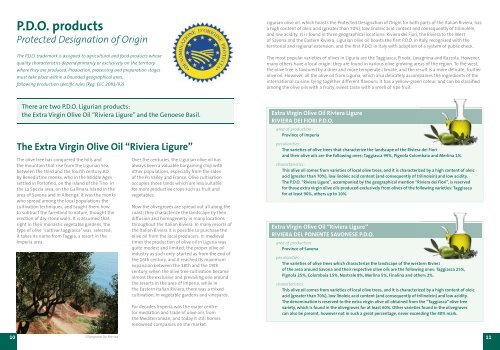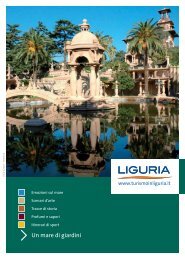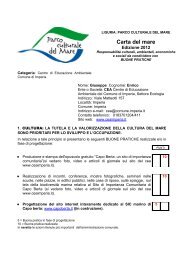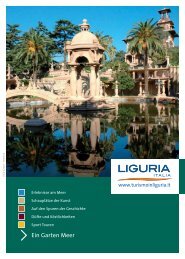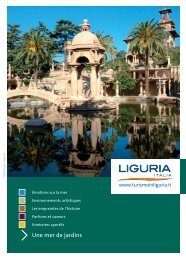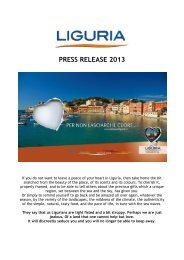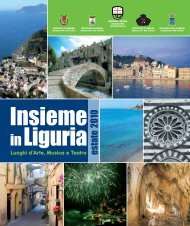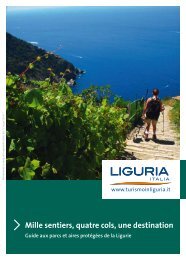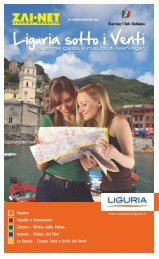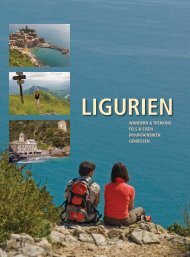Liguria, land of quality - Turismo in Liguria
Liguria, land of quality - Turismo in Liguria
Liguria, land of quality - Turismo in Liguria
You also want an ePaper? Increase the reach of your titles
YUMPU automatically turns print PDFs into web optimized ePapers that Google loves.
P.D.O. products<br />
Protected Designation <strong>of</strong> Orig<strong>in</strong><br />
The P.D.O. trademark is assigned to agricultural and food products whose<br />
<strong>quality</strong> characteristics depend primarily or exclusively on the territory<br />
where they are produced. Production, process<strong>in</strong>g and preparation stages<br />
must take place with<strong>in</strong> a bounded geographical area,<br />
follow<strong>in</strong>g production specific rules (Reg. EEC 2081/92).<br />
<strong>Liguria</strong>n olive oil, which boasts the Protected designation <strong>of</strong> orig<strong>in</strong> for both parts <strong>of</strong> the italian riviera, has<br />
a high content <strong>of</strong> oleic acid (greater than 70%), low l<strong>in</strong>oleic acid content and consequently <strong>of</strong> tril<strong>in</strong>ole<strong>in</strong>,<br />
and low acidity. it is found <strong>in</strong> three geographical locations: riviera dei fiori, the riviera to the west<br />
<strong>of</strong> savona and the eastern riviera; <strong>Liguria</strong>n olive oil boasts the first P.d.o. <strong>in</strong> italy, recognized with the<br />
territorial and regional extension, and the first P.d.o. <strong>in</strong> italy with adoption <strong>of</strong> a system <strong>of</strong> public check.<br />
The most popular varieties <strong>of</strong> olives <strong>in</strong> <strong>Liguria</strong> are the Taggiasca, P<strong>in</strong>ola, Lavagn<strong>in</strong>a and razzola. however,<br />
many others have a local orig<strong>in</strong>; they are found <strong>in</strong> various olive grow<strong>in</strong>g areas <strong>of</strong> the region. To the west,<br />
the olive tree is favoured by a drier and more temperate climate, and the result is a more delicate, fruitier<br />
olive oil. however, all the olive oil from <strong>Liguria</strong>, which also delicately accompanies the <strong>in</strong>gredients <strong>of</strong> the<br />
<strong>in</strong>ternational cuis<strong>in</strong>e, ty<strong>in</strong>g together different flavours; it has a yellow-green colour, and can be classified<br />
among the olive oils with a fruity, sweet taste with a smell <strong>of</strong> ripe fruit.<br />
There are two P.D.O. <strong>Liguria</strong>n products:<br />
the Extra Virg<strong>in</strong> Olive Oil “Riviera Ligure” and the Genoese Basil.<br />
The Extra Virg<strong>in</strong> Olive Oil “Riviera Ligure”<br />
The olive tree has conquered the hills and<br />
the mounta<strong>in</strong> that rise from the <strong>Liguria</strong>n sea,<br />
between the third and the fourth century ad<br />
by benedict<strong>in</strong>e monks, who <strong>in</strong> the Middle ages<br />
settled <strong>in</strong> Port<strong>of</strong><strong>in</strong>o, on the is<strong>land</strong> <strong>of</strong> the T<strong>in</strong>o <strong>in</strong><br />
the La spezia area, on the gall<strong>in</strong>ara is<strong>land</strong> <strong>in</strong> the<br />
area <strong>of</strong> savona and <strong>in</strong> albenga. it was the monks<br />
who spread among the local populations the<br />
cultivation techniques, and taught them how<br />
to subtract the farm<strong>land</strong> to nature, thought the<br />
erection <strong>of</strong> dry stone walls. it is assumed that<br />
right <strong>in</strong> their monastic vegetable gardens, the<br />
type <strong>of</strong> olive “cultivar taggiasca” was selected;<br />
it takes its name from Taggia, a resort <strong>in</strong> the<br />
imperia area.<br />
over the centuries, the <strong>Liguria</strong>n olive oil has<br />
always been a valuable barga<strong>in</strong><strong>in</strong>g chip with<br />
other populations, especially from the sides<br />
<strong>of</strong> the Po valley and france. olive cultivation<br />
occupies those <strong>land</strong>s which are less suitable<br />
for more productive crops such as fruit and<br />
vegetables.<br />
now the olivegroves are spread out all along the<br />
coast; they characterize the <strong>land</strong>scape by their<br />
diffusion and homogeneity <strong>in</strong> many locations<br />
throughout the italian riviera. <strong>in</strong> many resorts <strong>of</strong><br />
the italian riviera it is possible to purchase the<br />
olive oil from the local producers. <strong>in</strong> medieval<br />
times the production <strong>of</strong> olive oil <strong>in</strong> <strong>Liguria</strong> was<br />
quite modest and limited; the proper olive oil<br />
<strong>in</strong>dustry as such only started as from the end <strong>of</strong><br />
the 16th century, and it reached its maximum<br />
expansion between the 18th and the 19th<br />
century, when the olive tree cultivation became<br />
almost the exclusive and prevail<strong>in</strong>g one around<br />
the resorts <strong>in</strong> the area <strong>of</strong> imperia, while <strong>in</strong><br />
the eastern italian riviera, there was a mixed<br />
cultivation, <strong>in</strong> vegetable gardens and v<strong>in</strong>eyards.<br />
for decades imperia was the major centre<br />
for mediation and trade <strong>of</strong> olive oils from<br />
the Mediterranean, and today it still homes<br />
renowned companies on the market.<br />
Extra Virg<strong>in</strong> Olive Oil Riviera Ligure<br />
RIVIERA DEI FIORI P.D.O.<br />
area <strong>of</strong> production:<br />
Prov<strong>in</strong>ce <strong>of</strong> Imperia<br />
peculiarities:<br />
The varieties <strong>of</strong> olive trees that characterize the <strong>land</strong>scape <strong>of</strong> the Riviera dei Fiori<br />
and their olive oils are the follow<strong>in</strong>g ones: Taggiasca 99%, Pignola Colombaia and Merl<strong>in</strong>a 1%.<br />
characteristics:<br />
This olive oil comes from varieties <strong>of</strong> local olive trees, and it is characterized by a high content <strong>of</strong> oleic<br />
acid (greater than 70%), low l<strong>in</strong>oleic acid content (and consequently <strong>of</strong> tril<strong>in</strong>ole<strong>in</strong>) and low acidity.<br />
The P.D.O. “Riviera Ligure”, accompanied by the geographical mention “Riviera dei Fiori”, is reserved<br />
for those extra virg<strong>in</strong> olive oils produced exclusively from olives <strong>of</strong> the follow<strong>in</strong>g varieties: Taggiasca<br />
for at least 90%, others up to 10%.<br />
Extra Virg<strong>in</strong> Olive Oil “Riviera Ligure”<br />
RIVIERA DEL PONENTE SAVONESE P.D.O.<br />
area <strong>of</strong> production:<br />
Prov<strong>in</strong>ce <strong>of</strong> Savona<br />
peculiarities:<br />
The varieties <strong>of</strong> olive trees which characterize the <strong>land</strong>scape <strong>of</strong> the western Riviera<br />
<strong>of</strong> the area around Savona and their respective olive oils are the follow<strong>in</strong>g ones: Taggiasca 25%,<br />
Pignola 25%, Colombaia 15%, Nostrale 8%, Merl<strong>in</strong>a 5%, F<strong>in</strong>al<strong>in</strong>a and others 2%.<br />
characteristics:<br />
This olive oil comes from varieties <strong>of</strong> local olive trees, and it is characterized by a high content <strong>of</strong> oleic<br />
acid (greater than 70%), low l<strong>in</strong>oleic acid content (and consequently <strong>of</strong> tril<strong>in</strong>ole<strong>in</strong>) and low acidity.<br />
The denom<strong>in</strong>ation is reserved to the extra virg<strong>in</strong> olive oil obta<strong>in</strong>ed from the “Taggiasca” olive tree<br />
variety, which is found <strong>in</strong> the olivegroves for at least 60%. Other varieties found <strong>in</strong> the olivegroves<br />
can also be present, however not <strong>in</strong> such a great percentage, never exceed<strong>in</strong>g the 40% mark.<br />
10 Olivegroves by the sea<br />
11


